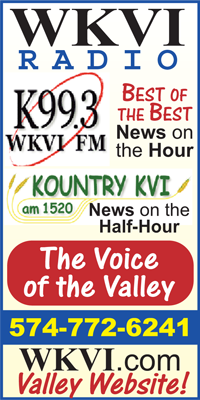An area of concern identified was the low percentage of college graduates in the county (10 percent), compared to the state average (20 percent), which illustrates two points - first, the county needs a better-trained workforce to retain and attract manufacturing; and second, it needs to secure jobs or business opportunities that will stem the “brain drain” (the exodus of our educated youth) from the county.
Presenters at the meeting were Leslie Wagner and Gerald Frazier of Ginovus, an Indianapolis economic development services firm.
What are the economic development strategies?
Wagner emphasized the importance of long-term planning for economic development. She outlined strategies identified by the USDA Rural Development Organization for the effective building of 21st Century Rural Communities:
-
Strategic Partners – strength in numbers.
-
Capital Markets – new investment stimulates local economies.
-
Regional Food Systems – building markets for locally and regionally-grown agriculture makes great sense.
-
Regional Collaboration – smaller communities do not have to stand alone.
-
Alternative Energy – development and use is good for the country and good for the local environment. (Wagner observed that this “makes enormous sense and it’s the right thing to do.”)
-
Broadband and Continuous Business Creation – expanding access to high-speed broadband is one of the greatest challenges.
In developing the plan Ginovus staff spoke with about 25 individuals in the county representing business, education, industry, utilities and government, among other interested parties.
Wagner noted the strength of agriculture in the county and stressed the need to build and maintain that heritage. She noted the aging population, which she views both as a strength (a source of experience and knowledge), and also as an economic opportunity. She also observed the county was home to a lot of business entrepreneurs and innovators.
She added there is a “strong sense of community with many willing to step up and serve the needs of the community,” and that many embrace the positive attributes of being a small, safe, rural community with good schools, churches and environmental assets.”
On the down side, she pointed out the county has no land-use zoning which will likely prove to be an obstacle to attracting new employers.
In reviewing the county’s economic statistics, Wagner noted there has been stability in the business community. There are over 1,200 employees in manufacturing who enjoy some of the best wages paid.
“It makes sense for the county to continue to attract manufacturing,” she said, “along with insurance and finance businesses which have also performed well.
How does aligning workforce with economic development initiatives help?
Frazier discussed community benchmarking for the purpose of studying economic situations in similar areas, and discussed the experiences of three selected counties from Iowa, Wisconsin and Kentucky.
He also addressed alignment of workforce with economic development initiatives, and extended his discussion to include workforce education issues, stressing the need for alignment among educators and business leaders to coordinate available education resources.
He pointed out that displaced workers need to learn new skills, and that the community must respond by providing assistance to help seasoned workers learn new skills.
“The norm in industry is constantly shifting,” he explained. “There is more competition and ever-changing technology which can contribute to job elimination.” He added that workforce training programs must be adult-focused, aligned to serve both employers and students/workers, be made affordable and held accountable.
For this purpose, the plan identifies many resources that exist for Pulaski County, including Ancilla College, Purdue Extension Programs and Technical Assistance Programs, customized training through Ivy Tech Community College and state programming such as the Indiana Department of Workforce Development.
What are the areas for focus and action?
The new economic development plan identifies five focus areas:
-
Impact of Property Tax Reform
-
County Niche Clusters
-
Real Estate Development Strategy
-
Performance Measurements
-
Key Action Steps
Wagner said the 2008 tax reforms – the shift from property tax to sales tax revenues - will likely have positive and negative impacts on Pulaski County’s economic development. She observed the more diversified economies should fare better.
In looking to the future, she encouraged the development of “cluster markets” in the county – those businesses and industries which buy and sell from each other and share ideas. Businesses can be stronger and more successful by virtue of being a part of a cluster than they would be in isolation by themselves because members also reinforce one another and can draw from a shared labor pool.
Wagner next discussed “location quotients,” information which gives indication of strengths and future success in a given area. Pulaski County’s agri-business/food processing & technology quotient is very high, and the transportation & logistics and manufacturing indicators are also quite strong – and (surprisingly) mining. These are assets that need to be promoted on websites and other outlets, she said, and targeted for further development.
With these factors in mind, Wagner outlined some emerging industries, such as wind energy and agriculture technology that play to the strengths of Pulaski County. With wind turbines in nearby counties, Pulaski could pursue service/production businesses which serve this industry. Wagner pointed out there is significant funding available in the clean energy fields.
Another emerging industry sector is technology/data center facilities which are used to house computer systems and associated components, such as telecommunications and storage systems. Today, technology/data centers are crucial to most organizational operations, thus increasing demand, Wagner said.
Another idea floated was the possibility of an agriculture renewable energy technology park. Wagner suggested the consideration of land acquisition for development of a planned business park along the west corridor of the county for creation of an agricultural technology park – “Ag Tech Park” – Pulaski County Agricultural-Renewable Energy Park “PCARE”. She explained this is a growing trend particularly in agriculturally rich states and communities.
What tools are available to help achieve these economic development goals?
Wagner said a “pro-active approach reaps significant dividends.”
The county should have a real estate development strategy. Winamac has an industrial park that is “Shovel Ready,” an asset that was complimented at the meeting. Francesville also has an industrial park with “a lot of promise” Wagner said, but has some issues to be cleared up, particularly in land acquisition.
She said consideration should also be given to “vibrancy of downtown,” observing that a “healthy downtown creates jobs, protects property values, increases options for goods and services, and serves as a symbol of pride and history.” Improvements can be as simple as walkways, attractive lighting and flowers.
Several possible financial tools were discussed, including tax options, general obligation municipal bonds, and state economic assistance.
Several questions were asked by the audience following the presentation. Many pertained to land-use zoning. An ad last week in a local paper had given many present the mistaken impression that the meeting was to be some sort of hearing on the county’s continuing process to develop a comprehensive land-use and zoning plan. These questions were briefly addressed. Other questions dealt with education and property/sales tax issues.
The proposed economic development plan will soon be available to the public on the www.pulaskionline.orgwebsite. The plan was made possible by a grant to the Pulaski County Board of Commissioners from the Indiana Office of Community and Rural Affairs.
For additional information, contact CDC director Dan Dolezal at This email address is being protected from spambots. You need JavaScript enabled to view it. or call 946-3869.







